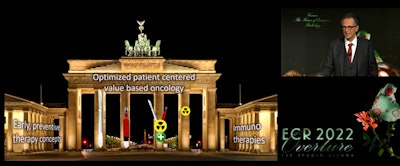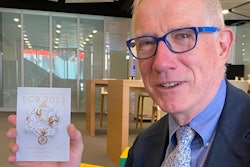
Interventional radiology has triggered a "blurring" of the boundaries in cancer management, and it will continue to blur the edges further in terms of who will treat patients, Dr. Adrian Brady told attendees at ECR Overture on 3 March.
Brady, a consultant radiologist from Mercy University Hospital in Cork, Ireland, said there has been an enormous change in the management of cancer over the span of his career. Cancer care used to happen elsewhere -- in surgery, or on the chemotherapy ward -- and radiologists never saw patients again after diagnosis. However, now interventional oncology offers patients procedures that can cure, ameliorate, or downstage disease, prolonging life in a meaningful way. The radiologist remains involved throughout, he noted.
"We as interventional radiologists are fully engaged in the process, barriers are broken down, and cancer management has moved to being true multidisciplinary care. In the future I see further blurring of cancer care roles as, ultimately, it's all about value for the patient," he said during the session, "Building bridges: interventional oncology, one of the four pillars in cancer care."
"By working together, we can enhance people's lives in the long run," added Brady, who is 1st Vice-President of the European Society of Radiology.
Raising awareness
Nevertheless, the panel concurred that interventional radiology is still not as visible or as accepted as a clinical specialty as much as it should be.
 Panelists for Thursday's interventional oncology session get down to business.
Panelists for Thursday's interventional oncology session get down to business.Prof. Afshin Gangi, professor and chair of radiology and nuclear medicine at University Hospital Strasbourg, explained how he had only accidentally become an interventional radiologist and called for more education on the topic at medical school.
"Thinking of interventional radiology as a clinical specialty is new; many specialties still see us as technicians, simply providing the treatment but not involved clinically with the patient, and not taking the lead," said Gangi, who is President of the Cardiovascular and Interventional Radiological Society of Europe.
"Interventional radiologists are the leaders in many diseases, particularly benign tumors, and we should be more visible as clinicians," he commented.
Other experts agreed, noting that more needs to be done to ensure patients benefit from the full range of procedures on offer. They agreed that the specialty remained little known, particularly among patients themselves, who weren't aware of alternative interventional procedures.
Penetration of interventional radiology into clinical care is important also for patients, as it is unfair to them that they don't have the chance to meet the radiologist face-to-face before procedures, or learn what interventional radiology can do for them ahead of any treatment decision, according to Brady.
Dedicated consultations
Session moderator Prof. Valérie Vilgrain, chair of radiology at the Beaujon University Hospital, Clichy, Paris, described how her department has launched dedicated interventional radiology consultations for patients. This has had an interesting range of patient reactions.
"We didn't invent the wheel, we are simply doing what the surgeons were doing before," she said. "A couple of weeks before the procedure, we have a clinical meeting with the patient to ensure the feasibility of the procedure and that there are no contraindications."
She described how patients were at first confused as to who the interventional radiologist was and whether or not a surgeon would actually perform the procedure. Thanks to these meetings, patients now have a clearer understanding of the process, she said. The "treating" radiologists should also see patients after the intervention to consolidate their follow-up role in the patient's pathway, alongside the medical oncologist.
To gain ground, Vilgrain believes that the focus of interventional radiology research needs to shift from effectiveness predominantly based on tolerance and safety, to efficacy with more attention paid to clinical outcomes as this will support value-based radiology. Therefore, interventional radiology procedures needed to be as systematic and stepwise as surgical resection to allow for strict comparison in terms of outcomes and cost.
"There needs to be standardization of all practice as this will be the best for the patient and the different specialties. Doing more [interventional radiology] cases won't reduce surgery that is necessary," Gangi noted.
Pillar 4 in cancer care
Presenting his case for making interventional oncology the fourth pillar of cancer care, Prof. Dr. Thomas Helmberger, head of the Institute of Diagnostic and Interventional Radiology and Nuclear Medicine, Klinikum Bogenhausen, Technical University of Munich, Germany, noted that there was already much evidence on outcomes from trials, but that it needed acceptance in the medical community.
Furthermore, there needed to be a shift from randomized controlled trials which were artificial and created bias, to registries, he said, pointing to large registries in the U.S. and France for hepatocellular carcinoma and other gastrointestinal cancers. These registries should be leveraged for data analysis and promotion.
 What's needed to optimize patient-centered value-based oncology? Prof. Dr. Thomas Helmberger provided some answers.
What's needed to optimize patient-centered value-based oncology? Prof. Dr. Thomas Helmberger provided some answers.Helmberger noted how 20% to 25% of colorectal cancer patients present with late-stage disease, often with metastases, and many of these patients are older and have comorbidities. Thus, a wide range of treatments are needed for different scenarios. In addition, demographics mean that cancer incidence is increasing, necessitating different treatment solutions to cope with growing strain on cancer services.
However, how does interventional oncology move from a useful tool to the fourth pillar of cancer care? For this, we must prove effectiveness through evidence, cost, and acceptance, he said.
Helmberger explained how in the literature, there was already enough evidence on outcomes: Studies showed there was no difference in survival outcomes between surgery and interventional oncology techniques, including combination therapies.
While outcome evidence was significant, it became more difficult to compare costs, as these differ between countries. Generally, as a single procedure, local ablative techniques are always cheaper than surgery, but entire cost processes needed further analysis.
The real stumbling block, however, would appear to be awareness and acceptance: a study of different international society guidelines and recommendations for cancer care revealed no mention of interventional radiology revealing a reluctance to implement interventional techniques, he concluded.



















